What can I say? Children judge hastily.
| FAMILY: CAMELIDAE FAMILY ▼ ▼ GENUS: Camelus Camelids ▼ ▼ ▼ ▼ SPECIES: Bactrian Dromedary Lama Auchenia ▼ ▼ Llama Vicuña Alpaca Guanaco | Those classified as true camels are the Camelus (Genus): the Bactrian camel and the Arabian dromedary. The others four are classified as Camelids (Genus) and all reside in South America. All living camels are descendents of the Camelops. |
| The two species of camels, llamas, and alpacas are now domesticated and primarily live as livestock. There are 1,400 Bactrian camels still in the wild and those are protected. The Guanaco and Vicuña also live in the wild. In addition, there are herds wild camels in Australia which were imported to that country in the mid-eighteen hundreds. |
| ▲ Living members of the Camelidae Family Image Source: biologydiscussion.com/origin-of-camels | Image Credit: Jjron ▼ Image Source: commons.wikimedia.org/w/Dromedary |
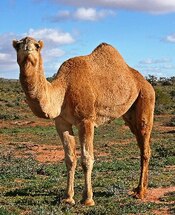
Dromedaries have one hump and are found in the Middle East, Northern India, and Africa. The species has been domesticated since ancient times and has not occurred in the wild for at least 2 thousand years.
The dromedary can lose up to 30% of its water content and is therefore able to withstand arid desert conditions. Throughout the Old World, they were used for transportation and as a pack animal. Many indigenous groups still rely on this species as a source of milk and meat.
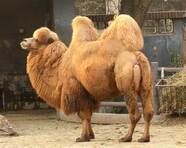
Bactrian camels have two humps and are found in the arid regions in central Asia. Specifically, they stick to the Gobi Desert of northern China and southern Mongolia.
oth Bactrian and Arabic camels are related but developed separately between .7 and 1.5 million years ago. Image Credit: J. Patrick Fischer ▲ Image
Source: commons.wikimedia.org/w/Dromedary
The conservation status of the wild Bactrian camel is considered critically endangered. The wild Bactrian lives in herds numbering from 6 to 30 members, depending on the availability of food and water. Its nostrils are long and very thin and it has a double set of long eyelashes. Both of these characteristics protect this species from the strong winds and blowing sands of desert storms.
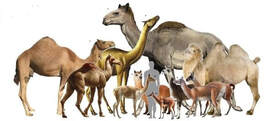
If you have ever attempted to develop a family tree, you know how difficult it is to organize and decide on the format. Out of at least a zillion charts, this was the easiest for me to read and understand. Adding to the confusion are the names of the families, genus, and species of the prehistoric camels. I apologize for any misinterpretations of the names and spellings. Also remember that picture are artist drawings based on the excavated skeletons.
Starting at the bottom of the chart, in the Eocene period of the Cenozoic Era, about 58 to 37 million years ago, the first progenitor of the camel evolved… the protylopus. Forget about pronunciation.
▼ Image Source: palaeopedia.tumblr.com/protylopus
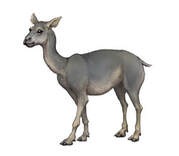
Three distinct Camelidae family lines began with the Protylopus: the Stenomylus, Paratylopus, and the Camelops, the main evolutionary line.
● Stenomylus Image Source: deviantart.com/Stenomylus ▼
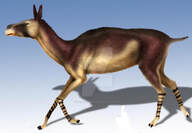
● Paratylopus
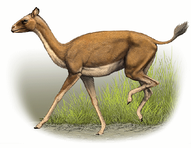
◄ Image Source: prehistoria.fandom.com/es/wi
This species is the main line of evolution of the camel, although some divergence in the line appears on the chart about 23 to 5 million years ago. Fossils remains show it ranges from Alaska to Mexico from the middle Pliocene to the end of the Pleistocene era.
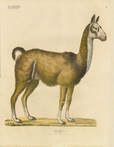
◄ Genus Auchenia
Image Source: https://www.philographikon.com/goldfuss.html
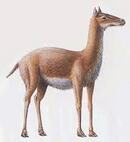
Genus Procamelus ▲ image source: parody.fandom.com//Procamelus
The shape of the toes suggests that it possessed foot pads, like modern camels, but unlike earlier forms of camelid, which generally had hooves. This would have helped it walk over relatively soft ground.
A wide variety of animals in this family branch coexisted during the Pliocene including the very large Titanotylopus. This species possessed long and massive limbs, a comparatively small braincase, and a convex slope between the eyes. Its average height was 11.5 feet at the shoulder.
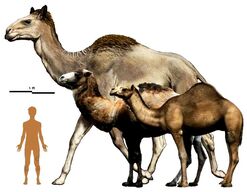
Other species had long necks like giraffe. Many of these species existed at the same time.
Titanotylopus (back), Camelops Hesternos, and dromedary (front).
Image source: reddit.com/titanotylopus ►
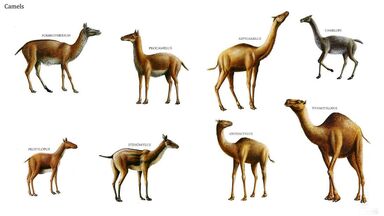
◄ Various species of the prehistoric camel
Image Source:
pinterest.com/pin/588212401301191643/
Thus, the origin of the camel family (Camelidae) is established as being North America based on finding fossils there.
During the Pleistocene era, around 3 million years ago, the first branch of this family, the Llama Auchenia, migrated to the south over the then-recently-created Isthmus of Panama. They spread out in South America where they evolved into the Llama, Alpaca, Guanaco and Vicuña. This is termed the Great American Interchange.
Image Source: bing.com/images/search
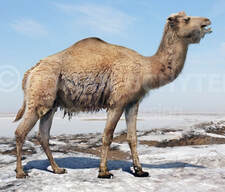
Camelops Hesternus ▲
Image Source: prehistoric-fauna.com/Camelops-hesternus
While there is no specific evidence for the reason so many animals migrated across Beringia, the logical assumption is that the increasing cold and lack of food forced many animals to seek a more hospitable living environment.
As far as the camel is concerned, the last surviving species in North America was Camelops Hesternus, “which vanished along with horses, short-faced bears, mammoths, mastodons, ground sloths, sabertooth cats and many animals, coinciding with the migration of humans from Asia at the end of the Pleistocene, around 15,000 to 11,000 years ago.” https://en.wikipedia.org/wiki/Camelops
Frankly, I’d put my money on the ice age as the reason for extinction, not humans.
Camelops Hesternus, as the camel foresighted enough to make his escape over the Bering Strait, traveled through Asia and India, and down into Africa, evolving into today’s Bactrian camel and Arabian dromedary.
Now, in the unlikely event that anyone asks you where camels originated, instead of laughing or saying something like “What’s the matter with you?”, you can astound the person with the saga of the Camelos. Or not.
JUST SAYIN
■
Sources:
https://en.wikipedia.org/wiki/Camelops#:~:text=Both%20the%20camel%20and%20horse%20families%20originated%20in,between%20Paracamelus%20and%20Camelops%20occurred%20about%2011%E2%80%9310%20Mya.
https://www.historicmysteries.com/camelops-north-american-camel/
https://www.quora.com/Where-did-camels-originate
https://equatorialminnesota.blogspot.com/2015/12/north-american-camels-not-run-of-mill.html
https://www.biologydiscussion.com/animals-2/origin-of-camels-biology/59721
https://www.history.com/news/giant-ancient-camel-roamed-the-arctic
https://en.wikipedia.org/wiki/Camelops
https://en.wikipedia.org/wiki/Paratylopus
https://www.livescience.com/27503-camels.html
http://www.fjcollazo.com/documents/CamelChron10.pdf
https://quatr.us/central-asia/where-do-camels-come-from.htm
https://www.thoughtco.com/the-pliocene-epoch-1091372
https://www.ibtimes.com/4-extinct-animals-roamed-america-giant-sloths-scimitar-cats-2558799
https://www.livescience.com/27503-camels.html
http://www.fjcollazo.com/documents/CamelChron10.pdf
https://quatr.us/central-asia/where-do-camels-come-from.htm
https://www.biologydiscussion.com/animals-2/origin-of-camels-biology/59721
http://www.india2australia.com/history-camels-australia/#:~:text=The%20history%20of%20Camels%20in%20Australia.%20Mostly%20camels,Malte%20Brun%20was%20a%20Danish-French%20geographer%20and%20journalist.
https://www.nationalgeographic.com/science/phenomena/2013/03/05/the-giant-camels-of-the-prehistoric-high-arctic/
https://valentint.blog.bg/zabavlenie/2015/12/18/largest-prehistoric-animals-vol-1-mammals-ch-11-camels-litop.1415919
https://www.worldatlas.com/articles/the-seven-extant-species-of-the-camelidae-family.html#:~:text=%20The%20Seven%20Extant%20Species%20Of%20The%20Camelidae,native%20to%20the%20Andes%20mountains%20and...%20More%20
Images only
https://commons.wikimedia.org/w/index.php?curid=2831408
https://www.pinterest.ca/pin/361132463861399333/
http://apps.dmns.org/whosepoo/Stage2.html
https://www.reddit.com/r/Naturewasmetal/comments/b7pvo4/titanotylopus_was_heavy_metal/
https://prehistoric-fauna.com/Camelops-hesternus
https://commons.wikimedia.org/wiki/File:The_age_of_mammals_in_Europe,_Asia_and_North_America_(1910)_(17322665784).jpg
https://palaeopedia.tumblr.com/post/151672450988/the-little-camel-protylopus-1898-phylum
https://dinopedia.fandom.com/wiki/Protylopus
https://www.geologyin.com/2016/12/10-interesting-facts-about-geological.html
http://www.dbriers.com/tutorials/2012/12/living-organisms-viewed-at-different-structures-of-organization/biological_classification/
https://www.researchgate.net/figure/Classification-of-the-Camelidae-family_fig1_276102908
https://www.frontiersin.org/articles/10.3389/fgene.2019.00017/full
https://www.pinterest.com/pin/588212401301191643/
https://www.bing.com/images/search?view=detailV2&ccid=3qwEFxhh&id=D8C42EACEA158DBBA56C2A3A003C60A1B1025D1D&thid=OIP.3qwEFxhhouZtOf_h2a4y7AHaEg&mediaurl=https%3A%2F%2Fqph.fs.quoracdn.net%2Fmain-qimg-fe1378aec191045b15f9b0a77e761fbc-c&cdnurl=https%3A%2F%2Fth





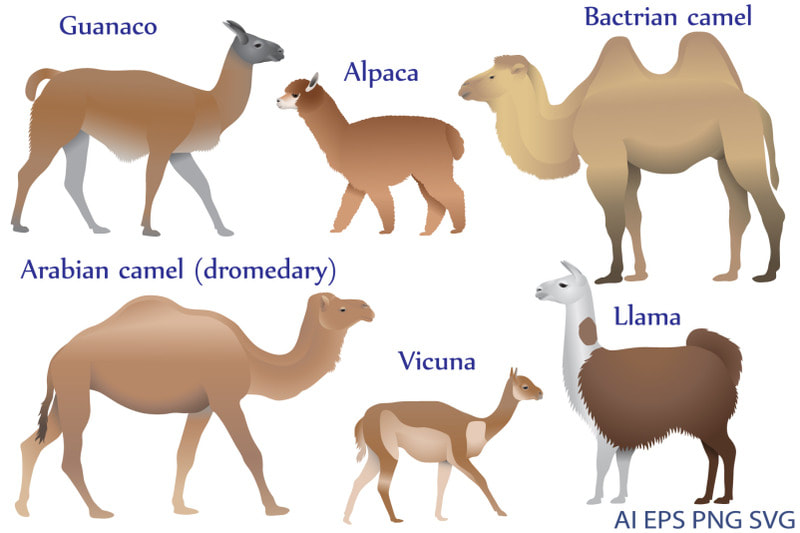
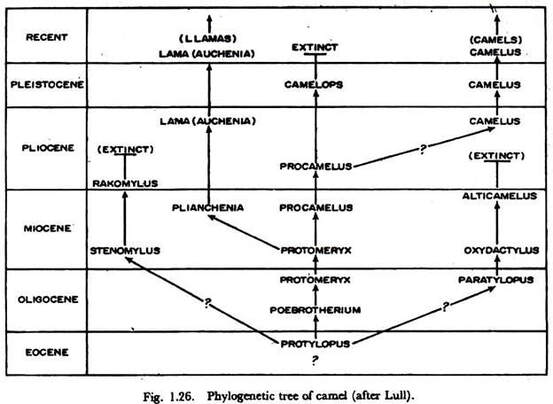
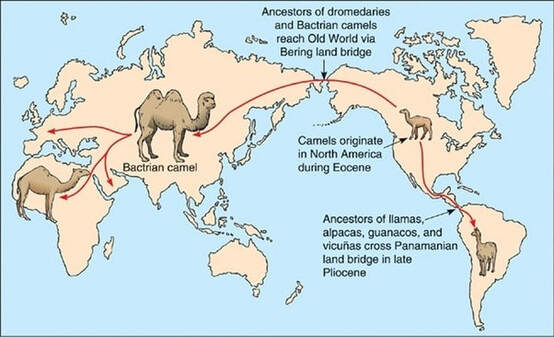
 RSS Feed
RSS Feed